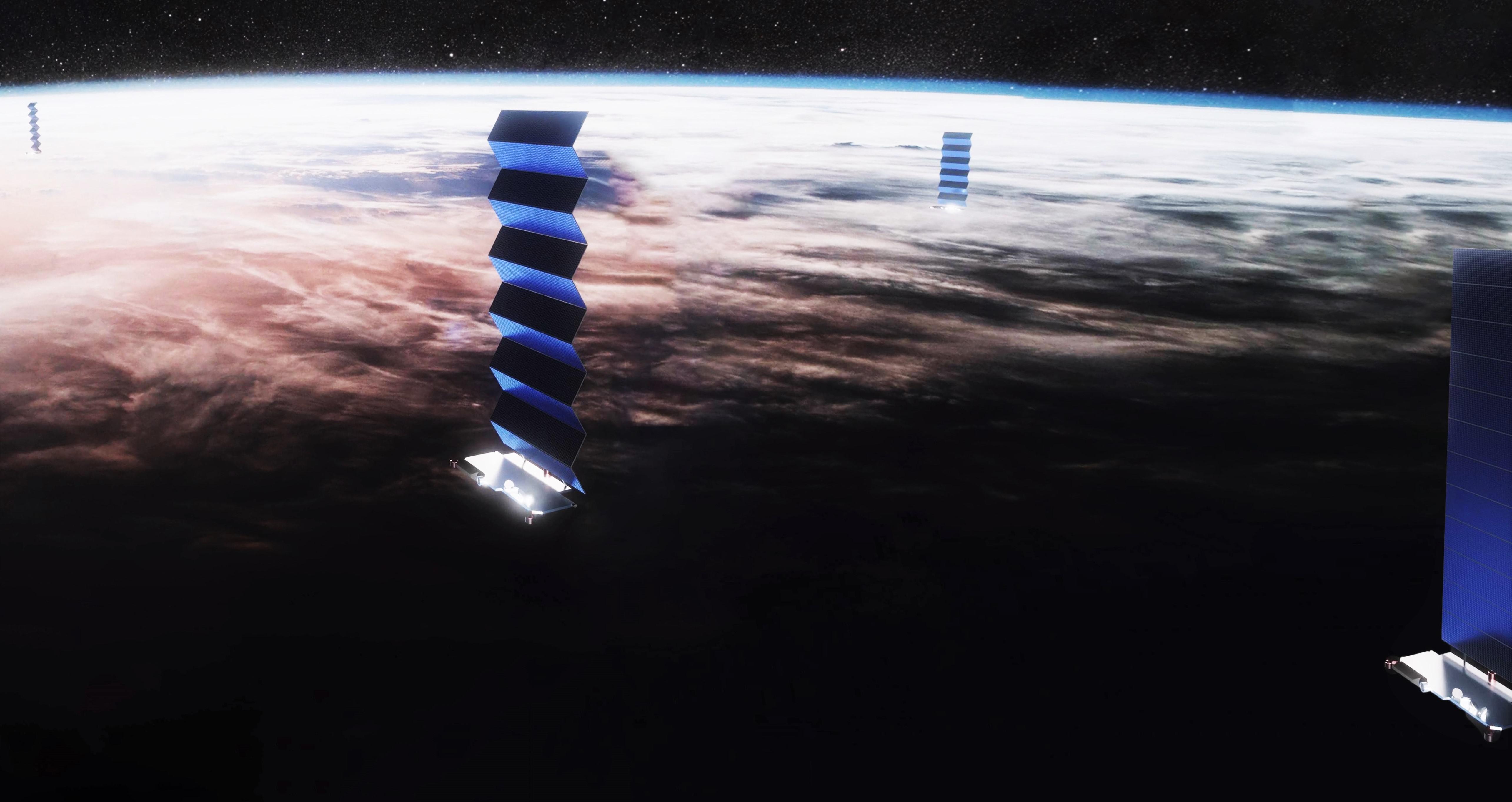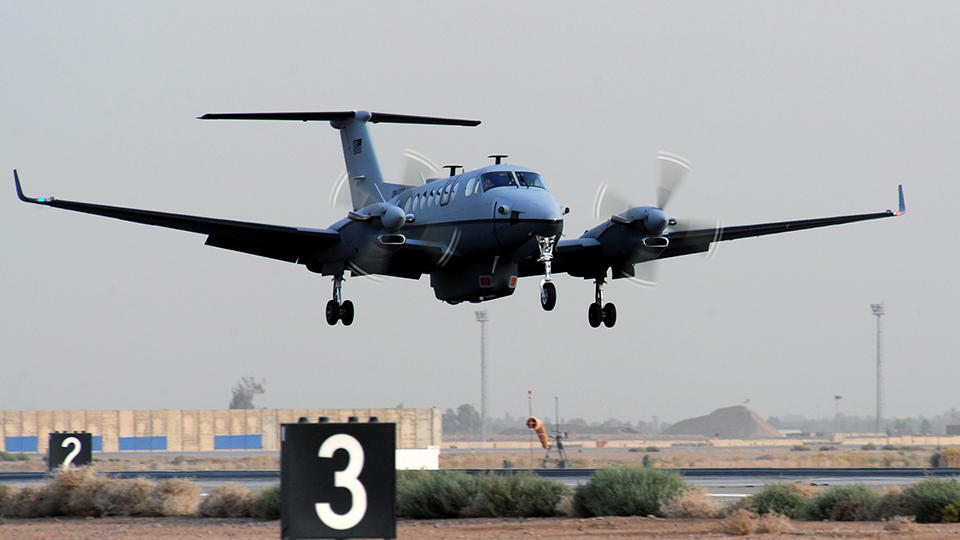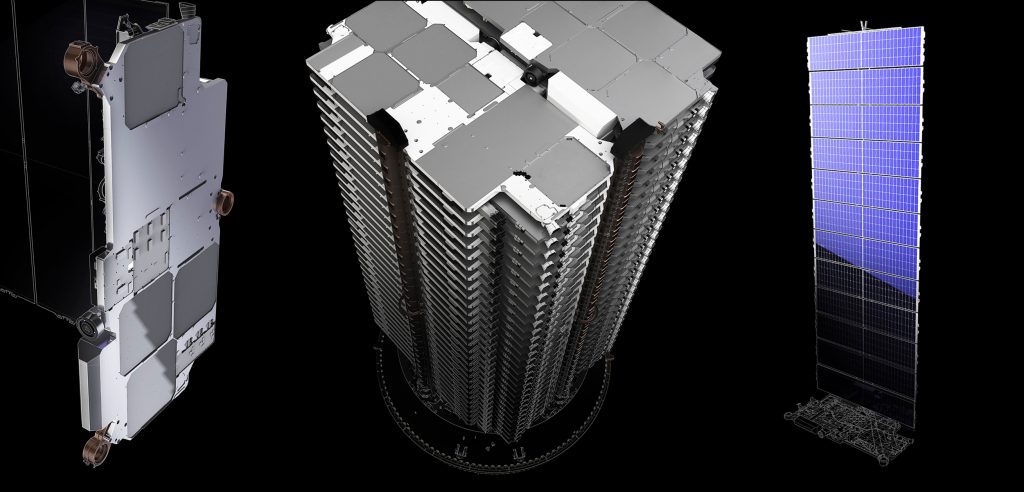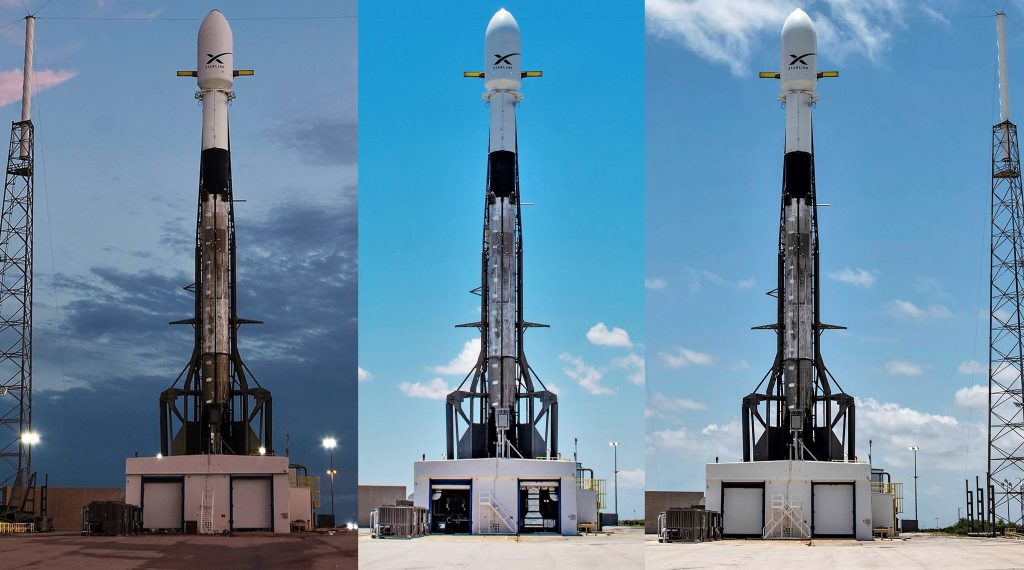

News
SpaceX’s Starlink satellite internet was tested by the US Air Force and the results are in
SpaceX President and Chief Operating Officer Gwynne Shotwell recently provided information about the company’s Starlink satellite internet constellation after a panel at the International Aeronautical Congress in Washington D.C. Shotwell spoke of a partnership with the U.S. military and just how far she believes Starlink is ahead of rival mega-constellation efforts.
While competitors are still developing very early prototypes and worrying about launch options, SpaceX has already launched 60 Starlink ‘v0.9’ satellite prototypes, 50 of which continue to successfully operate in low Earth orbit approximately half a year after launch. As part of a $29M contract awarded in late-2018, SpaceX is also working directly with the U.S. Air Force to test military applications of commercial space-based internet.
As previously reported by Teslarati, SpaceX was awarded a $29 million contract in December 2018 to collaborate with the U.S. Air Force Strategic Development Planning and Experimentation Office. Together, the organizations are testing potential military applications of Starlink satellite internet, as well as prospective constellations from other companies like Telesat.
From LEO to aircraft

The technical viability and utility of beaming high speed, low-latency broadband internet directly into the cockpits of military aircraft is being tested under a program called Global Lightning. SpaceX has engaged the initiative and was awarded $29M to pursue development and testing, far more than any other contract recipient. In October 2019, SpaceX and the USAF began publicly discussing the latest results of that effort to test Starlink’s capabilities in the realm of in-flight connectivity. As reported by SpaceNews, SpaceX COO Gwynne Shotwell revealed that Starlink had successfully demonstrated a data link to the cockpit of a military aircraft with a bandwidth of 610 megabits per second (Mbps), equivalent to a gigabyte every ~13 seconds.
Following a previous speaking engagement on Oct. 15th at the Association of the U.S. Army’s annual conference, Shotwell and U.S. Army officials provided further insight regarding military applications of Starlink. Army officials spoke about the possibility of using Starlink satellite internet and other prospective constellations to support the military’s rapidly growing demand for high-speed communications.
During the panel with U.S. Army officials, Shotwell stated that “SpaceX is new to this forum and this service,” when addressing the possibilities that SpaceX could provide for the U.S. military. While working with the military is not a new concept to SpaceX, serving as a satellite communications provider would be unlike anything the company has yet attempted.
Up next, the USAF has plans to install Starlink terminals and test connectivity with an AC-130 gunship and a KC-135 tanker aircraft.
Falcon 9 to support frequent Starlink launches – customers and rocket reusability benefit
While Shotwell acknowledged the potential of a partnership with the US. military, she also noted that Starlink is first and foremost a commercial business meant to enhance the internet experience globally and nominally provide connectivity to anyone that wants it. She further noted that Starlink would remain an “additive to [SpaceX’s] business,” implying that it will not supersede SpaceX’s current launch service business.
Intriguingly, this is utterly counter to forecasts SpaceX has provided investors over the last several years, in which Starlink – if successful – would almost certainly come to produce one or two magnitudes more income than launch services ever could. Shotwell – speaking to a variety of US military (and Air Force) officials – may have wanted to avoid sending the message that SpaceX’s launch services business – crucial to the US military – might soon be absolutely dwarfed by Starlink revenue.

Previously hinted at by CEO Elon Musk, SpaceX hopes that revenue from Starlink will enable the company to independently fund the development and mass-production of its next-generation Starship launch vehicle, eventually enabling a permanent, large-scale human presence on Mars.
Currently, SpaceX’s Starlink plans involve several distinct phases, beginning with ~1500 satellites around 500km, another ~2900 around 1000 km, and an additional ~7500 in the 300-400 km range. Finally, SpaceX recently revealed even longer-term plans for Starlink that could involve launching up to 42,000 satellites, all in the name of expanding network coverage and bandwidth – pending, of course, consumer demand. To accomplish that feat, SpaceX will have to push rocket reusability to the absolute limits, beginning with Falcon 9 boosters and fairings and ultimately moving to Starship. According to Shotwell, “(SpaceX’s) intent is to use Starlink to push the capability of those boosters and see how many missions they can do.”

SpaceX’s next Starlink mission – also the company’s next mission and first launch in more than three months – will simultaneously attempt two new rocket reusability firsts, marking the first time that SpaceX has reused a Falcon payload fairing and the first time a single Falcon 9 booster has launched four times. Starlink-1 is scheduled to lift off no earlier than 9:55 am ET (14:55 UTC), November 11th.
Check out Teslarati’s Marketplace! We offer Tesla accessories, including for the Tesla Cybertruck and Tesla Model 3.
News
Tesla Robotaxi has already surpassed Waymo in this key metric
Tesla Robotaxi has already overtaken Waymo in Austin in one key metric, but there’s still more work to do.

Tesla Robotaxi has already surpassed Waymo in one extremely important key metric: size of service area.
Tesla just expanded its service area in Austin on Monday morning, pushing the boundaries of its Robotaxi fleet in an interesting fashion with new capabilities to the north. Yes, we know what it looks like:
🚨 Tesla’s new Robotaxi geofence is…
Finish the sentence 🥸 pic.twitter.com/3bjhMqsRm5
— TESLARATI (@Teslarati) July 14, 2025
The expansion doubled Tesla Robotaxi’s potential travel locations, which now include the University of Texas at Austin, a school with over 53,000 students.
The doubling of the service area by Tesla has already made its travel area larger than Waymo’s, which launched driverless rides in October 2024. It became available to the public in March 2025.
According to Grok, the AI agent on X, Tesla Robotaxi’s current service area spans 42 square miles, which is five square miles larger than Waymo’s service area of 37 square miles.
Tesla Robotaxi (red) vs. Waymo geofence in Austin.
Much can be said about the shape… but the Robotaxi area is now ~3.9 mi² (10 km²) larger than Waymo’s!! pic.twitter.com/dVfh2ODxJC
— Robin (@xdNiBoR) July 14, 2025
The service area is one of the most important metrics in determining how much progress a self-driving ride-hailing service is making. Safety is the priority of any company operating a ride-hailing network, especially ones that are making it a point to use autonomy to deploy it.
However, these companies are essentially racing for a larger piece of the city or cities they are in. Waymo has expanded to several different regions around the United States, including Arizona and Los Angeles.
Tesla is attempting to do the same in the coming months as it has already filed paperwork in both California and Arizona to deploy its Robotaxi fleet in states across the U.S.
As the platform continues to show more prowess and accuracy in its operation, Tesla will begin to expand to new areas, eventually aiming for a global rollout of its self-driving service.
News
Tesla Megapacks arrive for massive battery replacing coal plant
Tesla Megapacks have started arriving on-site to the Stanwell Battery Project, just as Queensland prepares to wind down the Stanwell coal plant.

The first of over 300 Tesla Megapacks have arrived to the site of a massive battery energy storage system (BESS) being built in Australia, dubbed the Stanwell Battery Project after a coal plant it’s set to replace.
In a press release last week, the Stanwell Battery Project announced that the first Tesla Megapack 2XL units had arrived to the site, which is located outside of Rockhampton in Queensland, Australia. The project will eventually feature 324 Megapack units, set to arrive in the coming months, in order to support the 300MW/1,200MWh battery project.
“The Stanwell Battery is part of the diversification of our portfolio, to include cleaner and more flexible energy solutions,” said Angie Zahra, Stanwell Central Generation General Manager. “It is just one part of the 800 MW of battery energy storage capacity we have in our pipeline.
“Capable of discharging 300 MW of energy for up to four hours (1,200 MWh), our mega battery will be one of the largest in Queensland.”

Credit: Stanwell
Did you know Tesla’s Lathrop facility churns out a Megapack every 68 minutes? That’s enough energy to power 3,600 homes for an hour per unit! ⚡️ pic.twitter.com/bG6fpHkB9O
— TESLARATI (@Teslarati) June 11, 2025
READ MORE ON TESLA MEGAPACKS: Tesla Lathrop Megafactory celebrates massive Megapack battery milestone
The state is working with government-owned company Yurika to facilitate construction, and the process is expected to create roughly 80 jobs. The project is expected to come fully online in May 2027, with initial commissioning of the Megapacks aiming for November 2025.
The Stanwell Battery is set to replace the nearby Stanwell coal generation plant, which the government is planning to wind down starting in 2026 as part of efforts to reach an 80 percent renewable energy generation ratio by 2035. Meanwhile, the government is also set to begin winding down the Tarong and Callide coal plants, while several other Megapack projects are being built or coming online. o ya
Tesla currently has two Megapack production facilities, located in Lathrop, California, in the U.S. and another that came online earlier this year in Shanghai, China. The Shanghai Megafactory shipped its first units to Australia in March, while both factories are expected to be capable of producing 10,000 Megapack units per year upon reaching volume production.
News
The Tesla Diner is basically finished—here’s what it looks like
The company first broke ground on the Diner, Drive-in, and Supercharger location in September 2023. Now, it has served one of its first internal customers.

Tesla has finally completed the construction of its highly anticipated Diner, Drive-in, and Supercharger in Los Angeles, and recent photos of the interior’s “retro-futuristic” style are making their way around the internet.
X user Brad Goldberg shared photos from the Tesla Diner site last Tuesday, depicting some of the Supercharger stalls, indoor and outdoor seating areas, multiple neon lights, and even an Optimus robot. Goldberg also noted that there had been a “flurry of activity on site” while he was snapping the photos last week, suggesting that the restaurant location could be getting close to opening.
The Tesla Diner also served one of its first internal customers in the past few days, as Elon Musk posted on X on early Monday morning that he had just finished up eating a meal at the site:
I just had dinner at the retro-futuristic Tesla diner and Supercharger.
Team did great work making it one of the coolest spots in LA!
The photos also show that the site is pretty much done, with some of them even showing vehicles charging at the charging stalls.
You can see some of the latest photos of the Tesla Diner below.

Credit: BradGoldbergMD | X

Credit: BradGoldbergMD | X

Credit: BradGoldbergMD | X

Credit: BradGoldbergMD | X

Credit: TeslaKing420 | X

Credit: TeslaKing420 | X

Credit: Brad Goldberg (via Sawyer Merritt on X)

Credit: Brad Goldberg (via Sawyer Merritt on X)

Credit: Brad Goldberg (via Sawyer Merritt on X)

Credit: Brad Goldberg (via Sawyer Merritt on X)

Credit: Brad Goldberg (via Sawyer Merritt on X)
READ MORE ON TESLA’S LA DINER: Tesla readies Drive-In Diner Supercharger for launch with app inclusion
When will the Tesla Diner open to external customers?
While it’s still not open to external customers yet, the news again suggests that the company could be close to an official opening date. Tesla first broke ground on the Diner in September 2023, after receiving a wave of building permit approvals throughout that year. Teslarati also covered much of the construction progress throughout last year, including when crews installed the first and second drive-in screens.
Located at 7001 West Santa Monica Boulevard, the idea was first discussed in 2018 by Musk and a few others on Twitter, featuring 1950s rock and roll, waiters on roller skates, and drive-in movie theater screens playing clips from some of history’s best movies. Notably, the photos of the front doors also show that the site will be open 24 hours a day, 7 days a week, whenever it does end up opening.
Tesla’s progress on Supercharger with diner, drive-in seen in aerial footage
-

 Elon Musk2 weeks ago
Elon Musk2 weeks agoTesla investors will be shocked by Jim Cramer’s latest assessment
-

 News2 days ago
News2 days agoTesla debuts hands-free Grok AI with update 2025.26: What you need to know
-

 Elon Musk4 days ago
Elon Musk4 days agoxAI launches Grok 4 with new $300/month SuperGrok Heavy subscription
-

 Elon Musk6 days ago
Elon Musk6 days agoElon Musk confirms Grok 4 launch on July 9 with livestream event
-

 News1 week ago
News1 week agoTesla Model 3 ranks as the safest new car in Europe for 2025, per Euro NCAP tests
-

 Elon Musk2 weeks ago
Elon Musk2 weeks agoxAI’s Memphis data center receives air permit despite community criticism
-

 News4 days ago
News4 days agoTesla begins Robotaxi certification push in Arizona: report
-

 News2 weeks ago
News2 weeks agoTesla sees explosive sales growth in UK, Spain, and Netherlands in June



















